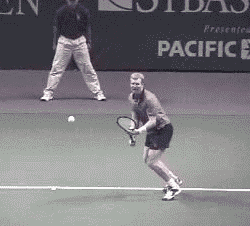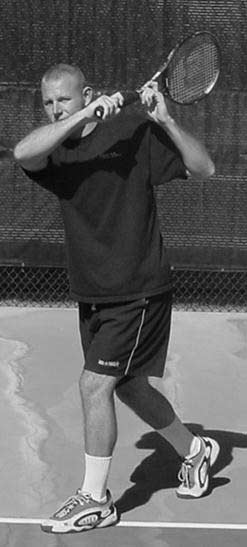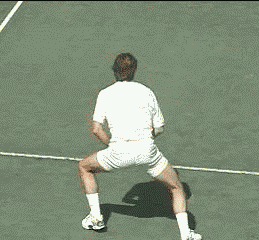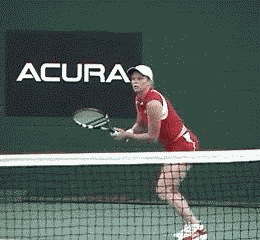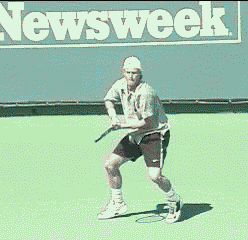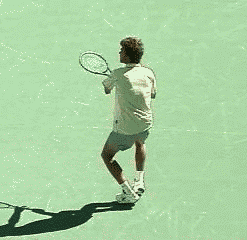|
TennisOne Lessons
The “Advanced Foundation”The Forehand Groundstroke within the Advanced Foundation
|
|
|
Whether you learn tennis via self-help books, videos or through such information as that provided here at TennisONE, or if you take tennis lessons for a period of time, it is absolutely imperative that you understand this concept and learn patterns that will lead you to the desired level of play you seek.
Years of teaching tennis and working with players of all levels and abilities has helped me develop a clear understanding of both human motor learning, (a degree in physical education and health-science also contributed to this understanding), and a certainty in what teaching philosophies actually contributed to long-term player progression for the vast majority of players. Through this recognition I began to form patterns of teaching that predictably would allow:
- players to learn methods that allow continued improvement without specific or required change
- players to evolve idiosyncrasies that were
- positive to player development
- player initiated—not skill-dependent
- many aspects of learning (and progressing) that DON'T require specific teaching for successful student improvement.
This concept has led to my teaching philosophy called the “Advanced Foundation.” Last month, I focused on the volley and the serve within this philosophy. This article will focus on the forehand groundstroke within the Advanced Foundation. However, prior to addressing the components of these strokes, I want to emphasize an issue that players will want to know when looking to develop their strokes within the Advanced Foundation. This issue deals with what stroke techniques should be learned and what does not need to be actively taught.
Self-working and Self-progressing Stroke Components
This topic deals with what specifically needs to be addressed in terms of stroke progression and what does not need to be specified. Learning within the Advanced Foundation provides for a great deal of proper self-working mechanics and progression. More specifically, a player who works within this foundation will find two things naturally occurring:
- More advanced aspects of each shot or stroke will naturally evolve when players become more familiar and comfortable with the technique
- Players will automatically integrate certain swing components that are usually desired within each complete swing pattern without having to be specifically taught.
These two benefits are probably the most appealing aspects for players who want to learn the game in such a way that they won't need to take a zillion tennis lessons. In addition, it is common understanding that tennis is a complex sport. Many players complain they have too many things to think about when they are trying to learn and execute tennis strokes. The fewer things a player needs to focus on, the easier it will be to execute those key points properly .
|
|
The Advanced Foundation creates an understanding that other correct extrinsic components will occur naturally for most people. (It is recommended that players take some lessons to make sure they are not developing either, a) exceptions from the natural progression, or b) specifically bad habits.)
I will identify many of the “self-working” or “self-progressing” aspects to these strokes as well as briefly describe why they are self-working.
The Forehand within the Advanced Foundation
Of all tennis strokes, the forehand features the greatest amount of diversity even among professional athletes. These variables include:
- Open and closed stances
- A great variety of grips
- A variety of backswing patterns
- A variety of pre-shot and post-shot footwork patterns.
This diversity has created a promulgation of such a wide variety of teaching beliefs that many in the teaching community have assumed that “there is more than one way to hit a tennis ball correctly.” And this is true. However, it must be understood that this is not an open-ended statement. That is, there is not an infinite number of ways to hit a ball that will result in both player progression and, eventually, skilled play. In fact, there are many methods that actually lead to player stagnation, or at best, mediocre play.
The Advanced Foundation recognizes there are indeed many ways to hit a forehand successfully. (Equally, they're exponentially more techniques that are recognized as being inadequate.) Thus, the forehand foundation in the Advanced Foundation is designed to allow the player to evolve their forehand within a foundation that not only allows this to occur in a progressive fashion, but one that also limits or eliminates developing bad habits or techniques that are recognized as being inadequate.
One and Two-handed Forehands
I am a big proponent of the two-handed forehand both as learning tool and an effective weapon (see the Lesson Library). However, while the two-handed forehand is an excellent stroke pattern being literally discovered by thousands of teaching pros and players alike, most players want to hit one-handed forehands. The advantages of working within the Advanced Foundation on the one-handed forehand will provide those players the working tools to learn or improve their forehand stroke.
|
|
Forehand Foundation
Grip
The grip used in the Advanced Foundation is the Eastern Forehand. This grip is not only used by a number of highly skilled players, it also allows players to evolve to the semi-western or even a full-western grip should players feel compelled to use those grips. I have found that this evolution occurs naturally and is based on several personal characteristics.
- Players who prefer an aggressive baseline game tend to migrate to more severe topspin grips. (Semi-western and full western.)
- Players who develop more of a serve and volley, or attack and volley style will favor the Eastern forehand grips.
These are generalities and don't always apply to all players. However, the eastern forehand grip in and of itself, can be taken to the highest level and does not need to be abandoned, as a player becomes more competitive. After all, there are dozens of top professionals who use all three of these topspin grips. The problem with starting off with a semi-western or western forehand grip is that these grips are so very foreign to almost all players, they end up creating some problematic stroke pattern to compensate for this unfamiliarity.
Backswing
I have found that, almost without exception, players who learn a straight back swing pattern can—and will—evolve their backswing technique, (loop, semi-loop), to meet their particular grip and personal swing preference. However, I have seen many players struggle with various aspects of a topspin forehand when first introduced with a loop backswing.
|
|
NOTE: Prior to the actual racquet backswing, it is critical that the player learns to first make a “Unit Turn.” This is the act of turning the shoulders and torso towards the forehand stroke prior to the racquet actually being taken back with the arm.
By making the unit turn, the player will tend to create a proper stroke pattern that integrates the upper body correctly. Several problems can arise when a player initiates the backswing with the arm without integrating the unit turn.
The aspect of backswing type is a feature that is, again, self-working and self-regulating. Players will almost always develop a personal preference as to loop size. (Among the pros, while most do indeed use some aspect of a loop swing, it is clearly a diverse component and not a core stroke pattern that is similar across all pros.) However, I have found that when the student is forced to learn a loop swing from the start, many players don't develop the physical understanding of getting the racquet down below the ball for the low-to-high swing pattern necessary for topspin development of the forehand.
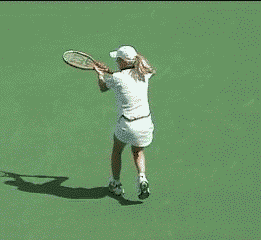 |
|
|
Footwork and Stance Patterns
It may be old-school, but players who first develop the forehand with a closed or neutral stance will almost always develop situational open-stance stroke patterns without specifically being taught this pattern. I have seen many players, however, who have been taught to hit forehands and/or backhands with an open stance develop some very bad upper body movements. (Opening up the upper body too soon, lunging at the ball, coming across the body instead of hitting through the ball, etc.)
Even as severe grips require much greater upper body rotation—and obviously more of an open stance as a generality—these players can learn how to create excellent torque and angular momentum working within neutral or closed stance patterns as a practice tool.
One important concept regarding footwork within the Advanced Foundation deals with the prevention of over-rotation at contact. Right-handed players who swing their back (right) leg around during contact, (or pull the front left foot away), tend to end up pushing the ball towards the target instead of stroking a topspin drive.
While advanced players have developed the timing to integrate these steps—usually as recovery steps—beginners and intermediate players tend to develop bad stroke patterns as well as poor balance if they indeed allow these footwork patterns to occur.
I have found that players who work to keep the back foot back, and the front foot down, generally develop proper balance and footwork to complement their stroke development. I have never had a player not be able to develop a “break step” or a “reverse pivot” correctly after learning to maintain a closed stance initially.
Backswing tools
One of the major stroke pattern problems beginning and low-intermediate level players encounter is the actual conception of a low-to-high swing. We seldom encounter players who can't hit a slice forehand. It seems that high-to-low swing patterns tend to be closer to natural human movements and swing associations. Also, because of gravity, it is more natural for a player to let the racquet fall during the swing than it is to physically swing up against gravity.
|
|
To help those who may have difficulty associating the proper low-to-high swing pattern, I have players actually touch the tip of the racquet to the ground on the backswing, hold it there until they initiate the upward swing pattern. By feeling the racquet touching the ground, the player has a physical “Key Position Point” they can associate. Too often, players can be told to get their racquet down on the backswing only to raise the racquet unconsciously prior to the start of the forward swing. Because the backswing is technically out of the player's sight, (since they are—or should be—looking forward to the incoming ball!), players lose focus on what the racquet is doing at this point.
This is an example of a “corrective tool” and does not necessarily fit our Advanced Foundation in terms of actually developing the overall advanced swing pattern. However, players who can't associate the low-to-high swing path will have difficulty developing any proper topspin stroke.
Follow-through
Most follow-through patterns tend to be dependent on grip and specific swing intention. That is, if a player wants to hit a massive topspin that dips fast and has minimal pace, this follow-through will usually be different than a forehand that is hit flatter as a drive for depth.
One of the big problems on the follow-through is when players try to finish with a “wrap” finish too early in the follow-through. A wrap finish is when the player allows the racquet and arm to come across the body after contact and ends up almost around the neck. Players must work to drive up and through the trajectory line long enough that the player doesn't lose the linear aspects of the shot. However, many pros over-stress this linear aspect and end up teaching the player to simply push the racquet through the ball with minimal angular momentum. If a player remembers to hit out towards the target and then finish with a wrap finish, they will usually develop proper and powerful forehands!
|
|
Conclusion
It is readily apparent that while touring pros hit with many idiosyncrasies—most of which are subtle personal embellishments—with very few exceptions the skilled players hit within a foundation that is similar among all players. The identifiable differences are usually in the preparation phase of each stroke: From the backswing on the forehand and backhand, to the backswing motion on the serve, the pros have developed diversity in this segment of stroke production.
Such differences have led many teaching pros to believe there must be more than one way to hit a tennis ball. And they are right…to a point. However, such idiosyncrasies are seldom taught; or need to be taught.
Players who develop the framework of strokes similar to those I present in the Advanced Foundation are free to develop these peculiarities that are usually complimentary to their particular personality and their strengths and weaknesses. To assume that any one of these aspects—from loop backswings to open stance footwork patterns—are the one-and-only, could indeed thwart players from developing to the best of their potential.
Players who work within the core stroke patterns I have recommended can be assured that the majority of idiosyncrasies will indeed contribute to overall stroke confidence and effectiveness.
 Your comments are welcome. Let us know what you think about this article by emailing us here at TennisONE.
Your comments are welcome. Let us know what you think about this article by emailing us here at TennisONE.
David W. Smith is the Director of Tennis for the St. George Tennis Academy in St. George Utah. He has been a featured writer in USPTA's magazine ADDvantage in addition to having over 50 published articles in various publications.
David has taught over 3000 players including many top national and world ranked players. He can be reached at acrpres1@email.msn.com.

